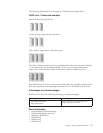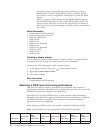
Advantages and disadvantages
RAID level-6 offers the following advantages and disadvantages.
Advantages Disadvantages
v 100% data protection
v Extremely high data fault tolerance
v Can sustain two simultaneous drive
failures
v Good solution for mission critical
applications
v Lower performance than RAID level-5
because of two parity drives
v Not supported on all controllers
More information
v Understanding RAID technology
v Understanding stripe-unit size
v Selecting a RAID level
v RAID level-0
v RAID level-1
v RAID level-1 Enhanced
v RAID level-5
v RAID level-5E Enhanced
v RAID level-x0
v RAID volumes
Understanding RAID level-x0
Note: RAID level-x0 is not available on all controllers.
RAID level-x0 refers to RAID level-00, 10, 1E0, 50 and 60. RAID level-x0 uses an
array of arrays, or a spanned array. The operating system uses the spanned array
logical drive in the same way as a regular array logical drive.
RAID level-x0 allows more physical drives in an array. The benefits of doing so are
larger logical drives, increased performance, and increased reliability. RAID level-0,
10, 1E, 5, 5E, and 6 cannot use more than 16 physical drives in an array; however,
RAID level-1E0, 50, and 60 support 60 to 128 drives.
RAID level-x0 requires a minimum of two drives and supports a maximum of 60
to 128 drives, depending on the controller.
The following illustration is an example of a RAID level-10 logical drive.
Chapter 3. Using ServeRAID Manager 45


















